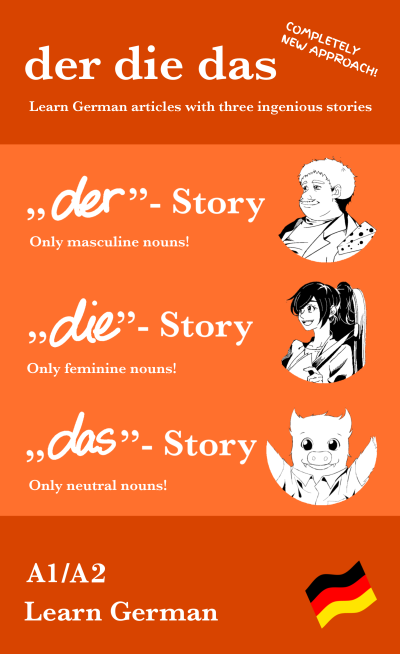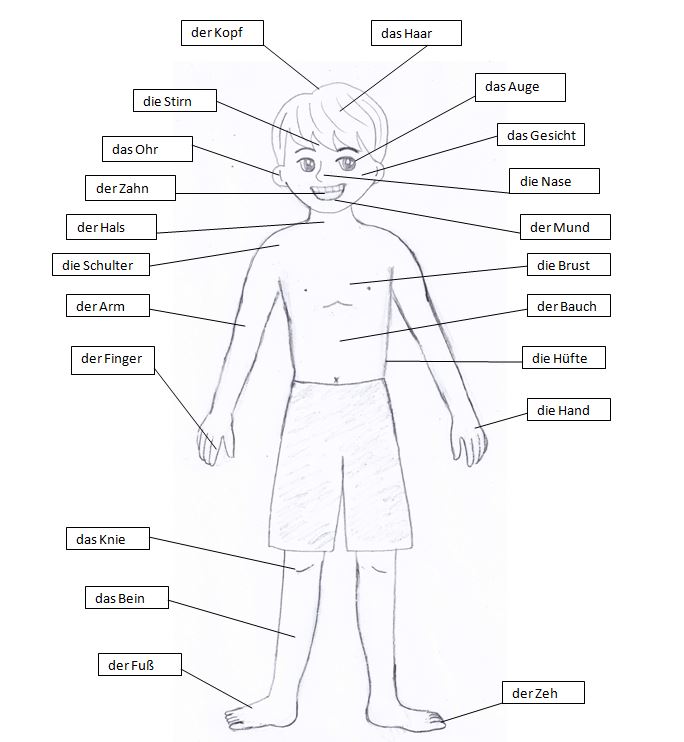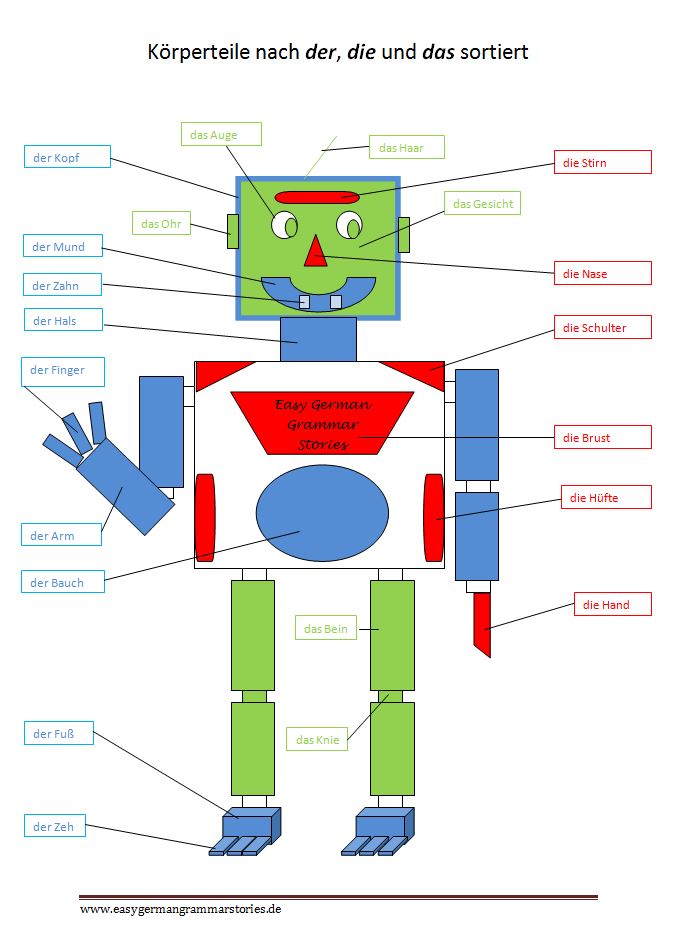
New: Learn German - der die das
Three easy German stories in one book: „der"-Story, „die"-Story und „das"-Story
German gender:der die das - How to learn German articles easily!How do I memorize whether a German noun is masculine, feminine or neutral? |
In German, there are three grammatical genders. Nouns can be masculine, feminine or neutral (neuter). You need to know the gender of the noun in order to use the articles and adjectives in front of them correctly. Sometimes you can recognize the gender from the ending of the noun. For example, if the noun has the ending -heit or -keit, the noun is always feminine. And some nouns can be sorted by meaning. For example, all alcoholic drinks are masculine: der Wein, der Whisky, der Schnaps, etc. There are just two exceptions: das Bier and die Bowle. However, many nouns do not follow a rule and you have to memorize them. Here I’ll show you how to do that efficiently.
Content
Introduction: How do we learn new information?
Tips and Tricks to remember der, die and das (noun gender)
Example 1: How to easily learn the gender of body parts in German
Example 2: How to learn the gender of nouns with a story
Three books to easily learn German articles and expand your vocabulary
How do we learn new information?
First, we need to understand that we learn new information in different learning styles:
Visual: We see the information (pictures, graphics, videos, etc.)
Tactile: We actively work with the information (painting, writing, etc.)
Auditory: We hear the information (audio, mp3, video, etc.)
Communicative: We talk to others about the information (discussion, application of the language, etc.)
Some people learn visually more easily than auditorily, while others learn better auditorily than visually. Everybody has a preference for one of these learning styles. Nevertheless, it is important to learn new information through as many learning styles as possible, because this helps us to remember the information better. In the following tips and tricks, we try to use as many learning styles as possible.
Tips and tricks to remember der, die and das (noun gender)
How do you memorize the gender of a noun when you cannot recognize the gender by looking at the ending or the meaning? Here are some tips. I will explain them below with examples:
• Always learn all nouns with the article (and the plural form). Vocabulary apps, such as Quizlet or Anki, or self-written word cards will help you.
• Give each gender a colour, for example: blue for masculine nouns (der Mann), red for feminine nouns (die Frau) and green for neutral nouns (das Kind). Write or underline the nouns in a text in these colours. Of course, you can choose different colours!
• Label everything in your home with small notes (post-its). Of course, you label masculine things blue, feminine things red, and neutral things green.
• Learn the masculine, feminine, and neutral nouns separately. Write the nouns on small cards or in lists on a sheet of paper. Choose a side for masculine and feminine. For example, put the masculine nouns on the left side and the feminine nouns on the right side. The neutral nouns are placed in front of you in the middle. As you learn, you take the masculine nouns in your left hand and turn your head to the left. So the nouns are assigned to a side, and later you can remember the gender better.
• Try these tips and see what suits you. Many of my students are often surprised by how well they work.
The quickest way to learn is to combine these learning techniques.
You might also like: Easy German books for beginners
Example 1: How to easily learn the gender of body parts in German
If you have to study the body parts in German, you usually get this kind of picture.
Well, it’s a nice picture but it’s also a bit of a mess.
der Fuß, das Bein, das Knie, der Finger, der Arm, die Schulter, der Hals, der Zahn, das Ohr, die Stirn, der Kopf, das Haar, das Auge, das Gesicht, die Nase, der Mund, die Brust, der Bauch, die Hüfte, die Hand, der Zeh
Step 1: We’ll sort the nouns by gender and give them a colour.
der Fuß, der Finger, der Arm, der Hals, der Zahn, der Kopf, der Mund, der Bauch, der Zeh
die Schulter, die Stirn, die Nase, die Brust, die Hüfte, die Hand
das Bein, das Knie, das Ohr, das Haar, das Auge, das Gesicht
Step 2: Now, we also give them a place.
|
der Fuß |
das Bein |
die Schulter
|
Step 3: Now let's paint a picture.
In the picture, we write the masculine nouns on the left side in blue, the feminine nouns on the right side in red, and the neutral nouns in the middle in green. Take a close look at the picture, and most likely you’ll easily be able to remember which parts of the body are masculine, feminine or neutral.
You see, there are many ways to tidy up the German gender mess. We sorted the nouns, assigned them to colours, gave them a place and painted a picture. All these activities help you learn new nouns.
You can also download the image as a PDF file for free.
Example 2: How to learn the gender of nouns with a story
You have to learn the following words:
die Zeitschrift, der Ausflug, der Biergarten, die Schüssel, der Freitag, das Haus, die Insel, das Land, das Märchen, die Musik, der Nachbar, die Erdbeere, der Schinken, der Spargel, der Spaziergang, das Wildschwein, die Wohngemeinschaft
Step 1 and 2: We sort the words and give them a colour and a place
|
der Ausflug |
das Haus
|
die Zeitschrift |
Step 3: Connect the nouns in a short story.
With these words, it's more difficult to paint a picture so we need a different learning technique. To remember them, we create short stories, because stories are always images that we see in our heads. For example, if you’re reading a novel, you’re also producing images of the novel in your imagination. Often these pictures are so clear and beautiful that you are later disappointed when you see the movie based on the novel because the images in your head were much better than those you now see in the movie. Your imagination is unique and better than any movie studio!
Masculine:
Ich gehe auf den Markt und kaufe Spargel und Schinken. Danach mache ich einen kleinen Spaziergang und treffe meinen Nachbarn. Wir machen einen Ausflug zum Biergarten.
Neutral:
Kennst du das Märchen von dem kleinen Wildschwein, das in einem hohen Haus auf dem Land lebt?
Feminine:
Ich lebe mit zwei Frauen auf einer kleinen Insel in einer Wohngemeinschaft. Es ist heiß und wir sitzen vor einer großen Schüssel mit Erdbeeren, hören Musik und lesen Zeitschriften.
Of course, as in the last sentence, you can also add other feminine words to make a better sentence, or to give the sentence a very clear hint (mit zwei Frauen) that all nouns are feminine. So, you connect well known information with new information and this makes it much easier to remember the new information.
Have the sentences recorded by a native speaker and/or read the sentences out loud.
Try to bring these stories to life as much as possible, try to produce pictures or a small film in your head.
Three books to easily learn German articles and expand your vocabulary!
If you liked these ideas and you want to build or consolidate your vocabulary, you may also like my three books: "der-maskuline Nomen", "die-feminine Nomen", and "das-neutrale Nomen". In each book, you’ll find a fun story with either only masculine, only feminine, or only neutral nouns. You also can listen to the stories on this page in the members' area, learn with word cards, and do many exercises. So you have everything you need to learn the gender of nouns efficiently.
Continue with: How do I know if a noun is masculine, feminine or neutral?




